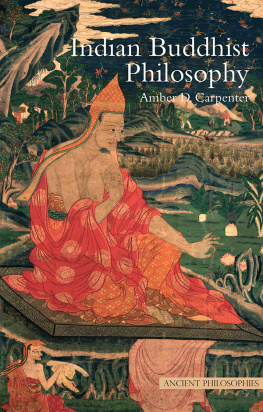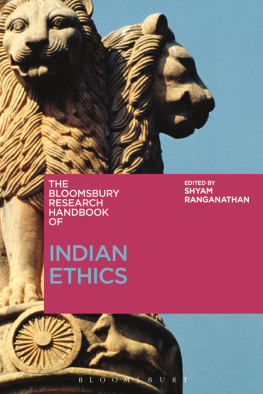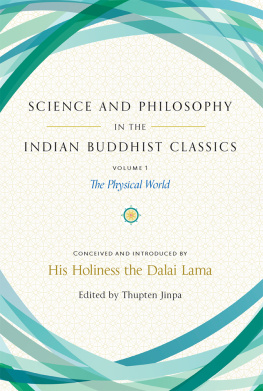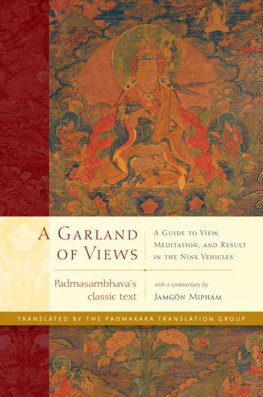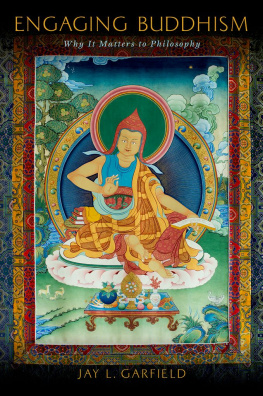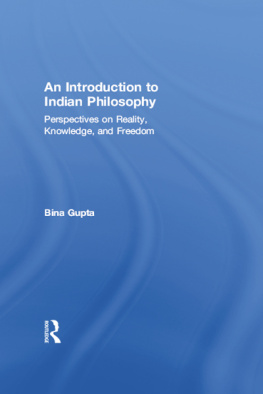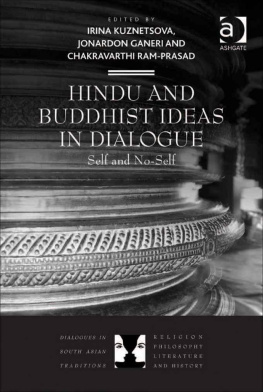Indian Buddhist Philosophy
Ancient Philosophies
This series provides fresh and engaging new introductions to the major schools of philosophy of antiquity. Designed for students of philosophy and classics, the books off er clear and rigorous presentation of core ideas and lay the foundation for a thorough understanding of their subjects. Primary texts are handled in translation and the readers are provided with useful glossaries, chronologies and guides to the primary source material.
Published
The Ancient Commentators on Plato and Aristotle
Miira Tuominen
Ancient Scepticism
Harald Thorsrud
Confucianism
Paul R. Goldin
Cynics
William Desmond
Epicureanism
Tim OKeefe
Indian Buddhist Philosophy
Amber D. Carpenter
Neoplatonism
Pauliina Remes
The Philosophy of Early Christianity
George Karamanolis
Plato
Andrew S. Mason
Presocratics
James Warren
Stoicism
John Sellars
Indian Buddhist Philosophy
Metaphysics as Ethics
Amber D. Carpenter

First published in 2014 by Acumen
Published 2014 by Routledge
2 Park Square, Milton Park, Abingdon, Oxon OX14 4RN
711 Third Avenue, New York, NY 10017, USA
Routledge is an imprint of the Taylor & Francis Group, an informa business
Amber D. Carpenter, 2014
This book is copyright under the Berne Convention.
No reproduction without permission.
All rights reserved. No part of this book may be reprinted or reproduced or utilised in any form or by any electronic, mechanical, or other means, now known or hereafter invented, including photocopying and recording, or in any information storage or retrieval system, without permission in writing from the publishers.
Notices
Practitioners and researchers must always rely on their own experience And knowledge in evaluating and using any information, methods, compounds, or experiments described herein. In using such information or methods they should be mindful of their own safety and the safety of others, including parties for whom they have a professional responsibility.
To the fullest extent of the law, neither the Publisher nor the authors, contributors, or editors, assume any liability for any injury and/or damage to persons or property as a matter of products liability, negligence or otherwise, or from any use or operation of any methods, products, instructions, or ideas contained in the material herein.
ISBN: 978-1-84465-297-6 (hardcover)
ISBN: 978-1-84465-298-3 (paperback)
British Library Cataloguing-in-Publication Data
A catalogue record for this book is available from the British Library.
Contents
If ancient philosophy remains alive, this is because it is about life. However abstract the debate may get (and it does get abstract), however abstruse the discussion, a thread leads back, anchoring it in the inescapable concern with how to live and how to be. This is true of the ancient Greek philosophers, which is why their work remains alive for us still; and it is equally true of the philosophers of ancient India, including the Indian Buddhist philosophers whose work is the focus of this book.
I cannot hope to have given a comprehensive account of Indian Buddhist philosophy, which spanned several centuries, and involved an enormous variety of interlocutors. In what follows, I have aimed instead to present only sufficient breadth that the reader may become oriented within the terrain, develop a sense for which sorts of concerns weighed with the Indian Buddhists, and how they articulated these concerns. And I have otherwise tried to focus on following through particular arguments, so that one might come to see what it is to do philosophy with these Buddhist philosophers and their texts, and come to appreciate how rewarding and how challenging this is. For although Buddhist philosophers remained alive to the basic questions and concerns that may resonate with anyone, they developed sophisticated conceptual tools and arguments for pursuing these. They challenged each other to make more precise articulations of their understanding of the Buddhas teachings, and to give more sophisticated defences of these views. When Buddhist thinkers were not imagining new and better ways of understanding the Buddhist position, and justifying them to each other, they were responding to pressures from non-Buddhist philosophers deeply sceptical of Buddhisms main metaphysical and epistemological commitments and therefore sceptical of Buddhisms basic ability to give a decent account of how we ought to live, think and understand ourselves.
The first chapter sketches the basic framework around which Buddhist thought was structured, and it offers an account of suffering that connects the metaphysical fact of suffering to the felt undesirability of it. examines the claim for which Buddhism was, and remains, best known (or, indeed, most notorious): the absence of self. I explore whether this should be taken as a claim about reality or as advice for a kind of praxis of dis-identification, before examining the arguments of the early Buddhist philosophers, who took it to be a claim about what there is, in need of explanation and defence. Their arguments lead them to adopt a sort of trope-theory, which rejects not only selves as underlying subjects and unifying agents but also any such complex wholes that might be thought to underlie or unite diverse properties.
Whether meant as a claim about what there is or as advice about how to think, the aim of the no-self claim is the same: to eliminate suffering by eliminating the causes of suffering, above all craving. We might ask how exactly this is supposed to work (How does seeing there are no selves eliminate craving?); we might also wonder, however it works, whether the game is worth the candle (Should I seek to eliminate suffering at the expense of eliminating all desires?). with Ngrjuna, the first named philosopher in the Buddhist tradition. His Madhyamaka interpretation of the Buddhas teachings claimed to go back to basics, to the more authentic meaning of the Buddhas words, and at the same time offered a systematic basis for the Mahyna view. His mode of argumentation is distinctive and difficult, relying on destructive tetralemmas that appear to countenance contradiction. I suggest that if we understand his form of anti- essentialism and anti-foundationalism, we may understand why he chose this elusive style of argumentation; yet foundationless metaphysics may also leave us without ground for moral improvement.
Central to moral thinking is not just the possibility for improvement, but the attribution of responsibility. to look at the sophisticated Nyya arguments for the existence of self. Experience itself, they say, demonstrates the unity-of-multiplicity distinctive of the self which the Buddhist would deny. Memory unites experiences at different times; desire unites different psychological modes (perception, memory) into a single moment. Buddhist minimalism, which seeks to eliminate all complex unities from the catalogue of really existing entities, may find it difficult to give an adequate account of memory, of individual responsibility, and even of desire the supposed root of suffering.
Vasubandhu takes Buddhist minimalism to the extreme. Recognizing that nothing can be located in space and still be absolutely simple, he argues that Buddhists must therefore be committed to there being nothing spatially located at all. considers his arguments, and whether the position he advocates should be called idealist. Answering this requires understanding Vasubandhus analysis of modes of existence, and of the preconditions for the possibility of any experience. The ultimate precondition, I shall suggest, is that of which Vasubandhu says nothing can be said, or thought and recognizing this fact is just what thoroughly transforming ourselves consists in.
Next page
